

Phonar Nation and Mobile, Connected Learning. Here is a presentation I delivered at MINA 2014 — 4th Mobile Creativity and Mobile Innovation Symposium, which took place November 20-21 at AUT (Auckland University of Technology) in Auckland, New Zealand.
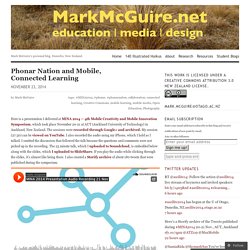
The sessions were recorded through Google+ and archived. My session (27:30) can be viewed on YouTube. I also recorded the audio using my iPhone, which I held as I talked. The Case for Connected Learning. A lot of my classmates don t get the importance of working with each other.
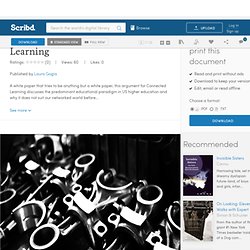
You know, you spend all that time in high school where you re told to write an essay and you don t get much back besides a graded essay. S it. Connected Learning in an Open World. At the beginning of this week I was in Greenwich, London for the first time in my life.

On Monday I travelled up the Thames from Embankment to Greenwich Pier by Clipper (another first) and stood on the decks of the Cutty Sark. On Tuesday I spent the day at the University of Greenwich’s APT2014 Conference, the reason for the trip. On Wednesday I stood on the Meridian Line at the Royal Observatory. A key question asked in the main exhibition room of Flamsteed House at the Observatory is ‘Where am I?
This related to how you can work out your exact location on the open seas, by knowing how to fix your latitude and longitude positions. One of the main reasons for attending the conference was to hear Stephen Downes speak. Connected Learning Visually Explained for Teachers. We have been talking a lot about the connected educator in the previous posts because we are in a month that is officially labelled the Connected Educator month, however, today we will have a cursory look into another closely related topic: connected learning.
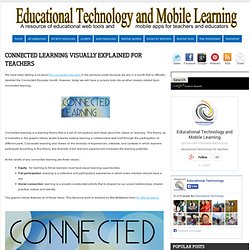
Teaching-in-the-CL-classroom.pdf. Ten Tips for Becoming a Connected Educator. We all know that education budgets are getting cut more and more, and that meaningful professional-development opportunities have unfortunately become a bit of an oxymoron in education.
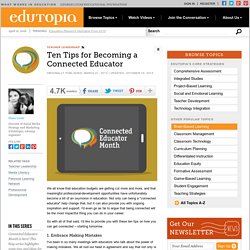
Not only can being a "connected educator" help change that, but it can also provide you with ongoing inspiration and support. I'd even go as far to argue that being connected will be the most impactful thing you can do in your career. So with all of that said, I'd like to provide you with these ten tips on how you can get connected -- starting tomorrow. 1. Embrace Making Mistakes. Connected Learning and Digital Literacy. ~ Connectivism ~ A word which I’d never encountered before three weeks ago.

A theory which is beginning to make sense to me. An area I’m growing my confidence in. This is my current understanding of what it means: Connectivism is the next evolution of the learning “-isms”: behaviourism, cognitivism, constructivism. The Essence of Connected Learning. From E-Learning to We-Learning. The corporate training industry is undergoing some major changes.

Over last few months we have been involved in many discussions with organizations about the tremendous needs to build, manage, and formalize their social and collaborative learning programs. This is being driven by many factors: the slowing economy, the "always-connected" nature of the workforce, and the explosion of social software tools and platforms now available. In many ways, this transition is very similar to the last "big thing" to hit corporate training - the "e-learning" era.
A Day in the Life of a Connected Educator – Using social media in 21st century classrooms. One of our main goals at Powerful Learning Practice is to turn educators into 21st Century educators.
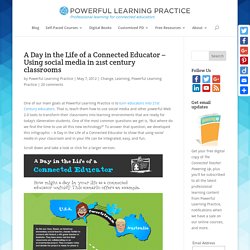
That is, teach them how to use social media and other powerful Web 2.0 tools to transform their classrooms into learning environments that are ready for today’s iGeneration students. One of the most common questions we get is, “But where do we find the time to use all this new technology?” Ten Tips for Becoming a Connected Educator. Learning 2.0 is Dumb: Use ‘Connected Learning’ Instead. Going forward, and as best I can, I’ll use the term ‘Connected Learning’ to describe a knowledge ecosystem made up of formal, informal and social learning behaviours and modalities.
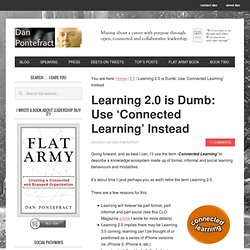
It’s about time I (and perhaps you as well) retire the term Learning 2.0. There are a few reasons for this: What Is Connected Learning? There are a ton of resources floating around out there about connected learning.
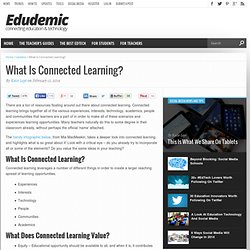
Connected learning brings together all of the various experiences, interests, technology, academics, people and communities that learners are a part of in order to make all of these scenarios and experiences learning opportunities. Many teachers naturally do this to some degree in their classroom already, without perhaps the official ‘name’ attached. The handy infographic below, from Mia MacMeekin, takes a deeper look into connected learning, and highlights what is so great about it! Look with a critical eye – do you already try to incorporate all or some of the elements? Do you value the same ideas in your teaching? Connected Learning Principles. We are living in a historical moment of transformation and realignment in the creation and sharing of knowledge, in social, political and economic life, and in global connectedness.
There is wide agreement that we need new models of education suited to this historic moment, and not simply new models of schooling, but entirely new visions of learning better suited to the increasing complexity, connectivity, and velocity of our new knowledge society. Fortunately, we are also able to harness the same technologies and social processes that have powered these transformations in order to provide the next generation with learning experiences that open doors to academic achievement, economic opportunity, and civic engagement. Connectivism. Learning in the Future. Overview Connectivism has been developed by George Siemens and Stephen Downes based on their analysis of the limitations of traditional learning theories to explain the effect technology has had on how we live, how we communicate, and how we learn.[1] According to co-developer Stephen Downes (2007), connectivism posits that “knowledge is distributed across a network of connections, and therefore that learning consists of the ability to construct and traverse those networks.[2]” As with constructivism and active learning, connectivism theorizes that knowledge is not acquired, as though it were a thing.
Knowledge is the set of connections formed by actions and experience. In connectivism, there is no real concept of transferring knowledge, making knowledge, or building knowledge.